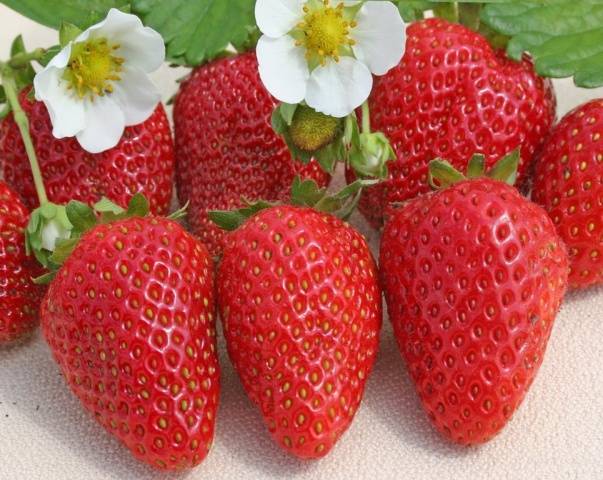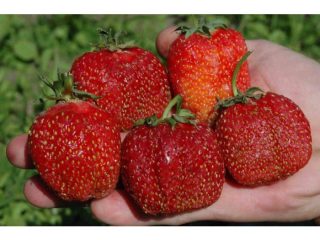Content
Growing strawberries (garden strawberries) is a hobby for some gardeners, but a real business for others. But regardless of this, everyone tries to acquire a unique variety that would not only produce a rich harvest of delicious, fragrant berries, but also would not require much effort in care.
Remontant strawberry San Andreas meets all of the above requirements. So that gardeners can verify this, we suggest that you read the description of the variety, photographs and reviews from our readers. Let's say right away that garden strawberries of the San Andreas variety are the product of Californian breeders. It is clear that the Russian climate is somewhat different, therefore, there are special nuances when growing and caring for strawberries. Gardeners, especially beginners, should know about them.
Description
Look at the photo. What beautiful berries the strawberry variety has! You yourself will be able to grow strawberries on your own plots. Having become acquainted with San Andreas strawberries in absentia based on the description of the variety, photos and reviews from gardeners, you will certainly go to plant them on your plot.
So, what is interesting about the overseas variety:
- The berries of the San Andreas variety actually correspond to those shown in the photo in the article. They are hard and shiny. Slightly rough to the touch due to deeply planted seeds. The fruits are bright red on the outside, but the inside is orange with white streaks.The berries themselves are hard, cone-shaped, with a slightly rounded tip. The taste is sweet with slight notes of acid.
- The berries adhere well to the stalk, and even when overripe they do not flow to the ground. Strawberry fruits are large, weighing about 30 grams, although some kind of giants can be found - up to 60 grams. Each berry is the size of a chicken egg. Look at the photo sent by gardeners.
- The density of the berries, which ensures excellent transportability, is highly appreciated by gardeners who grow strawberries for sale.
- The bushes of the garden strawberry variety San Andreas are not too large, the leaves are light green. The root system, unlike many varieties of this crop, is powerful and branched. This also affects productivity.
- Strawberries produce little mustache, so to replace plantings, some of them must be rooted.
- During the budding period, the plant throws out up to 10 thick peduncles that can hold a crop of ripening berries. Look at the photo to see what varietal strawberries look like during fruiting - everything is in accordance with the description.
- When applying agricultural technology standards, you can get more than a kilogram of delicious juicy berries from one bush.
- Remontant strawberries are a day-neutral variety, that is, a decrease in daylight hours does not affect fruiting. As a rule, it begins in May, the last berries are picked in October. The berries ripen in waves in 5-7 weeks. The July heat somewhat reduces the fruiting of strawberries of this variety. To prevent this from happening, nets or awnings are pulled over the plantings. In a summer cottage, this can be done to save the harvest.
- San Andreas garden strawberries can resist many diseases and pests due to their high immunity.
- Since fruiting is abundant and long, the plants must be fed several times during the growing season.
Features of agricultural technology
Even a beginner can grow strawberries Andreas, since caring for them is not much different from other varieties of remontant garden strawberries. The main thing is to take into account agrotechnical standards.
First, you need to prepare a fertile bed by adding peat, humus, compost or mineral fertilizers.
Secondly, when planting, there should be at least 30 cm between San Andreas strawberry bushes, and up to 40 cm between rows. It is better to plant seedlings in the fall. Plants are well watered and the soil is mulched.
Then the plantings need to be updated.
Thirdly, as gardeners note in reviews, the San Andreas strawberry variety has a high need for watering and fertilizing. Does not tolerate the slightest drought. A drip irrigation system will help solve the problem of drying out beds.
Moreover, even a beginner does not have any special problems with its installation. The simplest drip irrigation can be organized using ordinary hoses, as shown in the photo below. What else is it convenient for? All strawberry crops frown upon wetting leaves, flowers and fruits with water. No matter how carefully gardeners use a watering can, strawberries cannot be avoided getting wet.
For the winter, the beds in the open ground are protected from frost. The degree of shelter will depend on climatic conditions.
Feeding
Based on the description of the botanical properties and characteristics of the variety, regular feeding is necessary during the growing season and when preparing plants for wintering. These are both minerals and organic matter.
Although in recent years, gardeners have been trying to move away from mineral fertilizers, giving preference to organic fertilizers. But that's not the point. The main thing is to feed the San Andreas variety several times a season, starting in early spring. According to the description, strawberries bear fruit several times during the summer, and the soil becomes depleted.
The video shows tips on how to feed strawberries without chemicals:
Strawberries of the San Andreas variety can be successfully grown in a greenhouse, especially if you cultivate on an industrial scale. Who doesn’t want to have such a harvest of large-fruited remontant strawberries as in the photo below. There is something to be proud of!
Diseases and pests
Although the variety is considered resistant to many diseases, as stated in the description, gardeners indicate in reviews that powdery mildew, white spot, strawberry mite, and aphids cannot always be avoided.
To destroy diseases and pests, special chemicals are used. The main thing is not to process strawberries while the fruit is ripening. Plants can be saved by garlic, calendula, dill and parsley planted in the beds.















